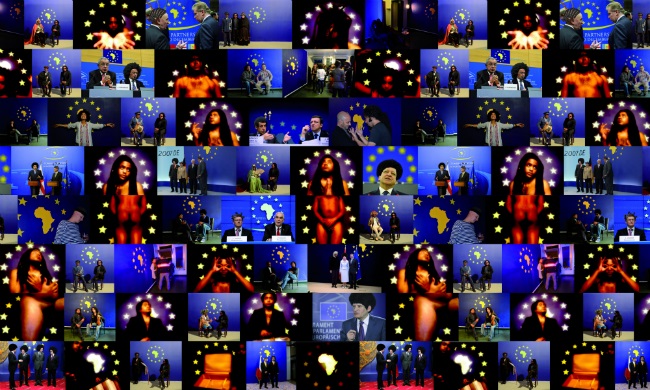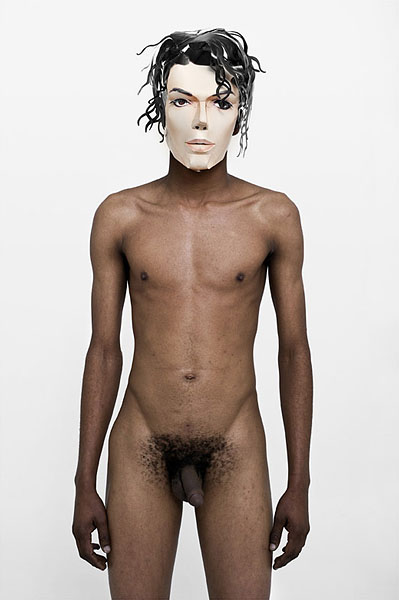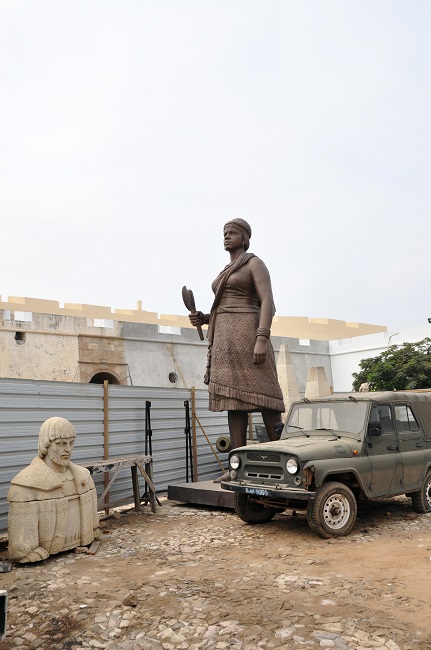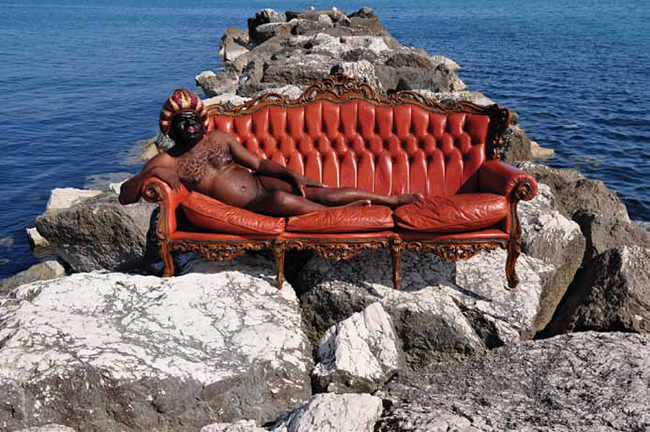
Bulumuka (Ambush), 2014.
Brundyn + Gallery, Cape Town.
KILUANJI KIA HENDA As god wants and the devil likes it
Until 30 August
Kiluanji Kia Henda’s As god wants and the devil likes it comprises a series of works concerned primarily with conceptions of Africa, its history and its future. Held at BRUNDYN+, the exhibition contemplates the aftermath of colonialism and its mark on the current Angolan physical, social and political landscape.
 As God Wants and the Devil Likes it (O.R.G.A.S.M.), 2014
As God Wants and the Devil Likes it (O.R.G.A.S.M.), 2014
The series Balumuka (Ambush) is a portrayal of an open-air transit zone in Luanda, one that has metaphorically and physically become a cemetery for numerous monuments that have throughout history found their way to pillars across the country. Amidst the occupants of this graveyard of history is a statue of Queen Nzinga Mbande who ruled Angola in the 1600s – she stands sternly in the enclosed yard, ironically juxtaposed against some of the main figures of colonialism, including Luis Vaz de Camões, Dom Afonso Henriques and Pedro Ànvadres Cabral. Through this juxtapositioning, Kia Henda uses the imaginary to reflect on numerous moments and perhaps versions of the history of the country, and in so doing, could be seen to automatically project a future for Angola. He provides an alternative to how history is perceived and comments on the (non)permanence, significance and historical heritage of objects of history. The photographs form part the series Homem Novo- New Man, which is a reference to the Angolan national anthem and reflects the nation’s aspiration to reinvent its national identity following their 1975 independence.
Accompanying this reimagined history and future for Angola is the series O.R.G.A.S.M (Organization of African States for Mellowness), which consists of two wall artworks that problematise the perception and perpetual representation of Africa as in constant need of assistance. Africa has perennially been represented as an AIDS-ridden, famine infested and war tormented space. British-Ghanaian scholar and artist Kodwo Eshun[1] theorises the need to create countermemories for Africa. Kia Henda adopts this strategy by appropriating the numerous American and European NGOs that flock to Africa to relive its suffering citizens of their dire socio-political circumstances. He does this by creating an imaginary African NGO, one that provides relief to Europe. Perhaps the artist is calling for a reflection on the reasons for the need to provide aid, thus echoing Slavoj Žižek’s[2] criticism of the speedy donations from the West without reflecting on the colonial, neocolonial and capitalist reasons that drove the so-called third world to what it currently is. The donations reinforce the superior-inferior relationship between Africa and the West and recalls Franz Fanon’s[3] analogy of the West’s paternal relationship to Africa. The aid is cathartic and provides a pleasurable and orgasmic experience for the donors.
Kia Henda’s video, Concrete Affection – Zopo Lady, is an eery and unsettling projection of an apocalyptic city. The video implements science fictitious strategies in its portrayal of an absence of people and life on earth. Adopting an Afrofuturist reading of the work, the occupants of the city could be seen to have been teleported to a different time, somewhere in the future, or to a different planet much like the one advocated for by Sun Ra, where black people move to Saturn in order to escape the “abjection, violation, and invisibility that Blacks occupy”[4] on earth.
BIOGRAPHY
Kiluanji Kia Henda (b. 1979) was born in Luanda and works between Luanda and Lisbon. His solo exhibitions have been held in galleries and institutions around the world, including his solo at the Kunstraum in Innsbruck (2013);
Self-Portrait As a White Man at Galleria Fonti in Naples (2010) and Portraits of a Slippery Look at the Gothe-Institut in Nairobi (2008). His group exhibitions include, among many others, Giving Contours to Shadows at the Neuer Berliner Kunstverein, Berlin (2014); The Shadow Took Shape, Studio Museum in Harlem (2013) and No Fly Zone: Unlimited Mileage at the Berardo Museum of Modern and Contemporary Art, Lisbon. Since 2005, Henda has participated in a number of biennales and triennials, such the Dak’Art Biennale (2014); 9th Bienal de Sao Paolo (2010); Trienial de Luanda (2010 and 2007); the Guangzhou Triennale (2008) and the Venice Biennale (2007).
 Athi-Patra Ruga: Deadboyz Auto Exotica #2 | 2009
Athi-Patra Ruga: Deadboyz Auto Exotica #2 | 2009
[1] Eshun, Kodwo. 2003. “Further Considerations on Afrofuturism”, The New Centennial Review. Vol. 3, No. 2, globalicities: possibilities of the globe (Summer 2003), pp. 287 – 302
[2] Žižek, Slavoj. 2011. “Denial: The Liberal Utopia” in Living in the End Times . London; New York: Verso, p.4
[3] Fanon, Franz. 1967. Black Skin, White Masks. New York: Grove Press
[4] Johnson, Paul. A Reading of Frank Wilderson’s Red, White, and Black, Contra/Pro Giorgio Agamben. Sounding Rhetoric, http://soundingrhetoric.blogspot.com/2014/05/a-reading-of-some-of-frank-wildersons_5930.html, [Accessed 15 July 2014]
Courtesy Brundyn+ Cape Town.



